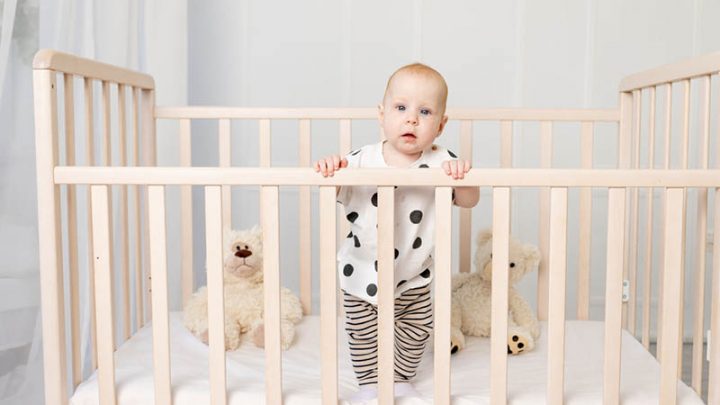You may have never asked yourself when to lower crib mattress height but it is something that many parents do wonder.
Experts say that you should adjust it as your baby becomes more mobile.
When she starts sitting, you put it in the middle setting and when she starts standing up, the lowest is your best option.
This is something that often doesn’t even cross the minds of many new parents.
After all, there are many more important things to worry about now that the baby is coming.
Believing that crib mattress height is not important is a mistake.
According to researchers, 10 000 babies end up in an emergency room every year because of a variety of crib, bassinet, and playpen accidents.
I’m sure you’ve heard about Sudden Infant Death Syndrome (SIDS), known as crib death.
This is why crib safety should be at the top of your list of priorities.
Of course, that includes, before anything else, the question of when to lower crib height.
When To Lower Baby Crib
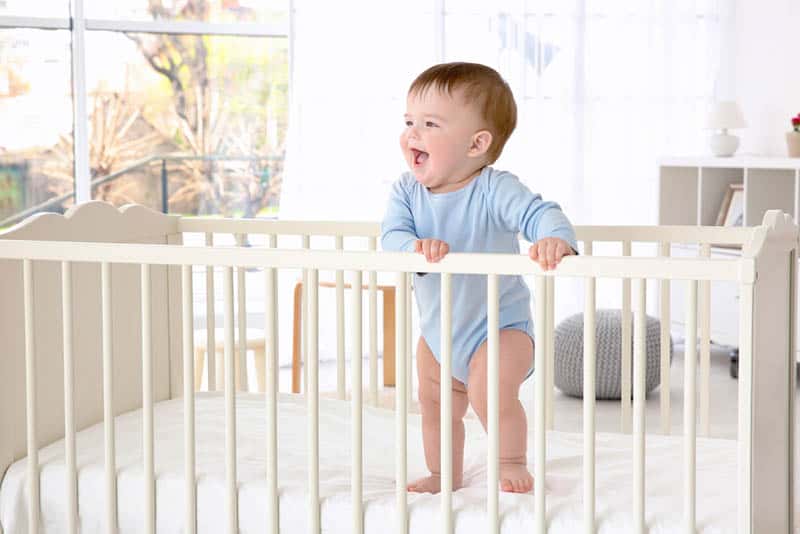
In case you didn’t know, a wrongly adjusted crib mattress is the number one cause of children’s injuries while in the crib.
Even if the mattress height was satisfactory when the baby just arrived, it doesn’t mean that you shouldn’t adjust it with time.
Keep in mind that your baby is growing at an exponential rate and therefore, you must modify everything around her to fit her perfectly.
When to lower crib height is something you might be wondering about.
Well, the American Academy Of Pediatrics (AAP) is there to give you the answer. After all, they’re the experts who can give you the best possible advice regarding your baby’s safety.
According to their recommendations, the perfect timing for lowering the crib is the moment your baby develops the ability to sit or stand up.
Of course, not all babies learn to do this at the exact same time but generally, they usually start standing up in the crib or while holding on to an object somewhere between 6 ½ and 8 ½ months.
Nevertheless, most babies don’t know how to pull to a standing position until they reach the age of 8 or 10 months.
Their abilities develop and finally, they know how to stand for a few seconds on their own between 9 and 11 ½ months.
Why is this important? Well, these are the milestones you should follow in order to figure out when to lower crib height.
The moment your baby starts sitting or standing up, it means she’s become much more active.
It is, therefore, highly likely that she has also learned how to climb and has reached greater mobility in the crib which means that she is more likely to fall out of the crib.
This is exactly why the APP recommends the following:
• When the top rail of the adjustable side is raised, it shouldn’t be lower than 26 inches from the mattress.
• When the top rail of the adjustable side is lowered, it shouldn’t be lowered than 9 inches from the mattress.
When To Lower Crib – 3 Stages Explained
The first stage

When you bring your baby home, you’re not only overwhelmed with happiness and joy.
Even though a lot of new moms refuse to admit this, the truth is that you’re also stressed out.
You wonder whether you’ll do everything right. Will you forget something?
What if you make a mistake right from the start?
One of your worries is definitely your baby’s crib.
In fact, you probably started stressing about this while you were still pregnant because you wanted everything to be ready and waiting for your little ray of sunshine.
The crib is probably already put together. What is crucial here is to follow all the guidelines from the manufacturer.
Don’t do anything your way and if you have a hard time assembling it, don’t be ashamed to ask for help from an experienced parent or a handyman.
On the other hand, if some things are unclear in the manual, don’t hesitate to contact the manufacturer.
After all, this is your most precious being in the world we’re talking about so nothing should be too much trouble.
If you’re not planning on using an infant bassinet, it means that the baby will sleep in the crib right away.
Alternatively, you can wait for her to outgrow the bassinet or you can combine the two: you can put your baby in a bassinet that rocks on its own during her naps but take her to the crib when she is sleeping longer hours during the night.
The next question is where to place the crib? Well, there are also some safety guidelines to follow here.
First of all, the important thing is to put the crib as far away as possible from all other furniture in the nursery, such as gliding chairs, etc.
That includes the wall as well.
The crib should be at least one foot away from all other objects in the room.
This minimizes the risk of your baby potentially hitting herself.
More importantly though, don’t place the crib near the window.
Your baby can’t sit or stand up at this point so it’s impossible for her to reach the window or fall down.
But, before you know it, she’ll grow, and when that happens, you’ll have to move all the furniture around for safety reasons.
So, rather just make the adjustments right away. I’m not saying that she will fall but it’s always better to be safe than sorry.
Keeping all of this in mind, the best place to set the crib up is close to the doors of the nursery.
This way, you can pick up your litle one the moment you enter the room.
Also, nighttime breastfeeding of your sleeping baby will be less complicated.
It will be easier for you to approach her without stumbling across the entire room without any light on.
RELATED: 11 Best Nursing Nightwear Choices For Easy Breastfeeding
Crib height
At this point, the crib should be adjusted to its highest setting.
The baby can’t sit or stand up by herself, so there is no danger of her falling out of the crib.
At this height, the baby will be within arm’s reach. It will be easier for you to pick her up when the baby’s crib mattress is positioned like this.
Let’s not forget that the crib is the place where your little bundle of joy will be spending most of her time.
Therefore, you want her to have the best crib mattress, natural crib sheets, and the most comfortable setting possible.
Picking your little bundle of joy up from this height is the safest for her neck and back.
But, let’s not forget about your back here either.
Lifting a baby up on a daily basis (which you’ll be doing countless times each day) is a common cause of back problems and back strain in new moms.
Even though the baby’s weight is still relatively low, it still puts stress on your back and entire body.
Therefore, lowering the crib mattress at this point would be harmful to both you and your newborn.
The second stage
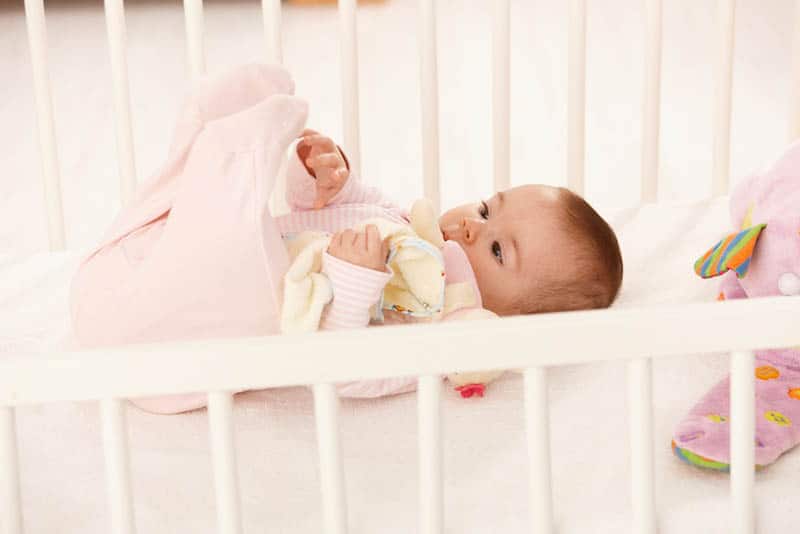
Every baby has a number of milestones.
Even though the idea of your baby walking seems like a distant event when she first arrives home from the hospital, don’t forget that they develop rapidly.
Before your baby develops enough to sit, you must adjust the crib mattress height in a way that will prevent her from falling out of the crib.
That means lowering it.
At this point, your little one will also start investigating her surroundings, and what better place to begin than the crib itself?
She’ll probably try to lean against the crib’s side. Even though her exploring is great, it’s also potentially hazardous.
It’s possible for her to tip the crib over which will make her fall down and consequently, hurt herself.
Now that your baby is mobile, it’s no longer safe to keep the crib in its highest position.
In order to adjust the crib the right way, you have to observe each one of your little one’s milestones carefully.
I’m sure you know that she won’t learn how to sit or stand up out of the blue.
Instead, there are some things that precede these events.
First and foremost, your baby has to develop a certain level of strength in her upper body before being able to sit up without anyone’s assistance.
Before that happens, she’ll be able to hold her head up (that usually occurs when the baby reaches 2 months of age).
After that, she’ll probably engage in pushing herself up with the help of her own arms.
This happens while the baby is lying on her stomach.
The next stage is holding her head firmly without anyone’s assistance – which usually happens around the fourth month.
When the baby starts holding her head up steadily, you know she’s almost ready to sit up on her own.
This is also typically when your infant will start rolling over.
Before that, she’ll begin rocking from one side to another.
Some babies prefer rolling over from their stomach to their back.
When the baby reaches 6 months of age, she is likely to learn how to sit. But at this point, she’ll need your assistance to do so.
The best way to help her and encourage her development is to give her the necessary support by surrounding her with pillows that will help her remain seated.
She’ll also begin rolling over in the opposite direction – from her back to the belly.
If you want to help her, put her favorite stuffed animal by her side. This way, she’ll have to roll over to pick it up.
Another great idea is to take your baby out of the crib and put her on the floor.
This way, she’ll have more room to roll over from one side to the other.
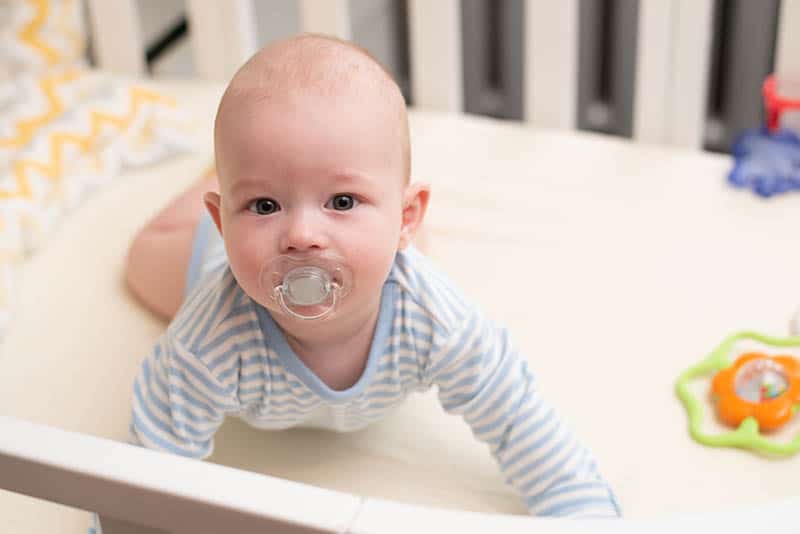
Of course, don’t forget to put a blanket or a natural play mat (make sure it has no harmful chemicals) on the floor to make the experience cozy and more enjoyable.
This is when your little one will likely begin rocking back and forth on her knees and hands.
When she starts doing this, it means she’s close to crawling.
Before she learns how to crawl forward, she’ll move backward.
Even though this might seem strange, there’s no need for concern as it’s a perfectly normal child milestone.
At approximately 9 months of age, she’ll probably develop the ability to sit up and lie back down, but at this point, she still needs you to give her a hand while doing so.
When your baby reaches 9 months of age, this is when she’ll start to creep and perfect her crawling technique.
She might even pull herself around on the floor by her arms.
Once more, use your little one’s favorite toy to assist you and encourage her.
But this time, place it a little further away, so that she has to move with her entire body to reach it.
Again, it’s better to perform these activities outside the crib.
The floor (with a blanket as far away as possible from the stairs) is, without a doubt, the best choice.
After all, it’s the only place she can’t fall off.
All of your baby’s abilities improve around her first birthday.
At this point, she develops the ability to get herself into the sitting position all by herself, without anyone’s assistance.
Crib height
At this point, it’s better to adjust the crib’s height even lower. Put it on the middle setting.
It would be best to do this between the child’s third and fifth month, even though she still won’t be mobile at this time – just to be safe.
Besides, this way, you’ll have plenty of time to get used to picking her up and reaching out to her from this position.
The third stage
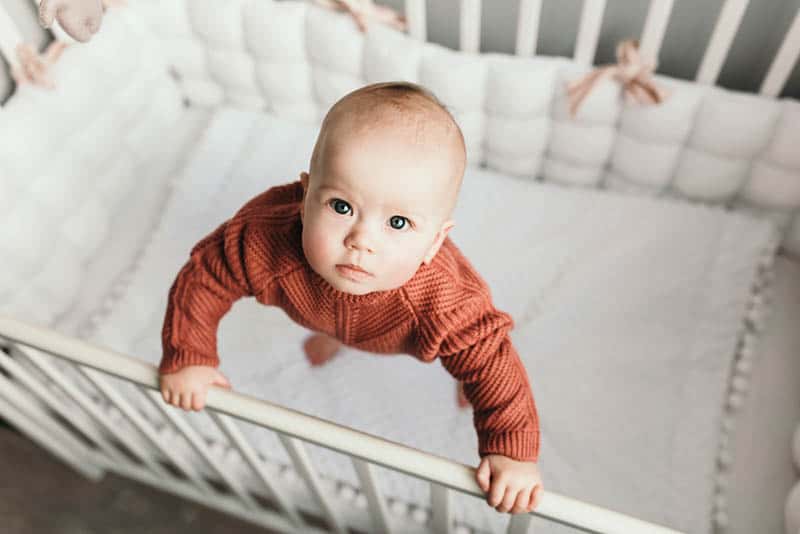
Before they start walking, babies learn to stand up. Based on most milestone charts, this happens in a few phases.
If your baby is between 6 ½ and 8 ½ months old, they’re likely to start standing with help.
I’m not talking about an adult’s assistance here only.
Instead, babies have a habit of grabbing things around them. At this phase, she will hold on to a steady object and stand like that.
When the baby reaches 8 to 10 months, she will pull herself to a standing position but still won’t be able to actually stand.
That changes around 9 to 11 months when your little one will be able to keep standing for a couple of seconds.
Of course, your little bundle of joy is completely unaware of all the potential dangers this milestone brings with it.
But luckily, she has you there to always have her safety as a number one priority.
Your baby still isn’t as stable as she’ll become later.
Therefore, tipping over and falling out of the crib can sadly happen in the blink of an eye.
Crib height
The moment you notice your little one trying to pull herself up or doing her best to stand up on her own, you should adjust the crib to its lowest position.
At this point, when your baby is exploring everything around her, accidents can happen very quickly.
Make sure you take the necessary precautions to prevent something like this from happening.
Ignore the fact that she still can’t stand up on her own.
She’s very likely to grab the crib’s fence to stand up just like she holds on to different objects around the house such as the table.
Corner posts
Every crib’s safety manual should warn you about the corner posts.
Even though they probably seem completely harmless to you, when you think about it, you’ll see that they can actually be the cause of many accidents.
It has been proven that every corner post higher than 1/16th of an inch can be the cause of suffocation or strangulation of a little child.
Don’t think that something like this is unlikely to happen.
When your child starts to move around the crib, her clothes can easily get stuck on a corner post.
Before you know it, this can cause her to be trapped and consequently strangled.
Even though the newer cribs cater for this risk and only sell cribs without post extensions, if you’re buying a used or an older product, don’t forget to take this feature into account.
If you already have a crib with corner posts that are above 1/16th of an inch, not everything is lost.
In most cases, the extensions can be removed without much trouble – you’ll need to unscrew or saw them off.
The fourth stage
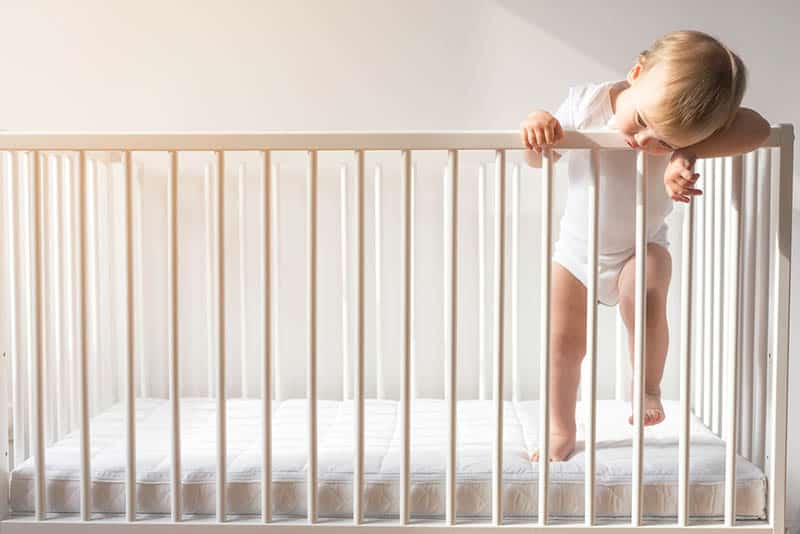
Now that your baby knows how to stand on her own, you’ll leave the crib positioned on its lowest setting for as long as your little one uses it. It’s also at this point that you ought to get rid of the padding.
Trust me: your baby is smarter and more skillful than you might think.
Even though this is probably something that never crossed your mind, she’ll use every opportunity to climb, which includes using the padding and bumpers in the crib.
Of course, this is also the stage when you should start considering which toddler bed is best for your little one.
Or you can get creative and make your own toddler bed instead of buying one – the choice is yours.
Other Safety Guidelines
The first thing you must keep in mind when we talk about the baby’s crib is that she will spend a lot of time in it.
Not only that, but for most part, she’ll be unattended in there.
After all, what’s the point of having a crib if you spend all your time watching the baby.
Even though I know you’d rather spend all day, every day next to your bundle of joy, sadly, it’s utterly impossible to do so.
Therefore, the baby’s crib must be the safest place in the world.
It’s not uncommon for a baby to fall out of the crib or to hurt herself in some other way while in it.
Nevertheless, there are safety measures you can put in place to avoid any type of injuries.
Besides, you want your child to be as comfortable as possible while laying down in her crib.
These are the things you must pay special attention to when buying a new crib:
1. Year of manufacture
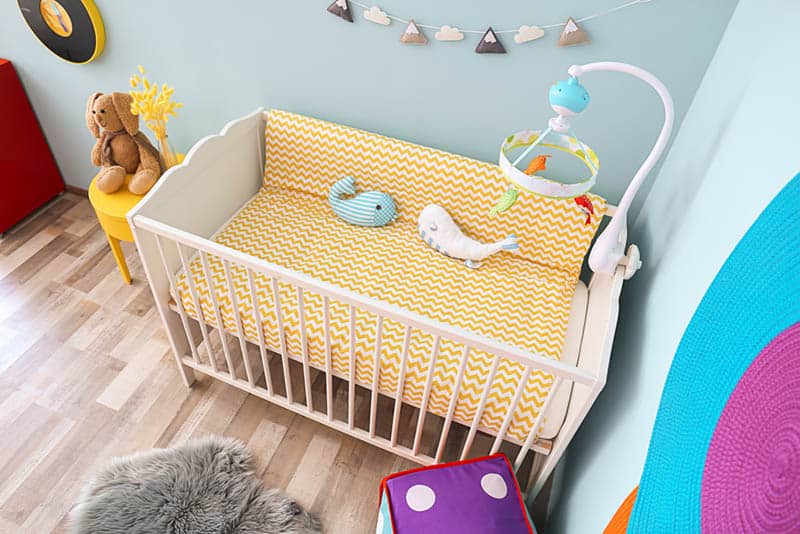
If possible, it would be best to purchase a crib that has been manufactured after 2011 because these products follow the guidelines from the Consumer Product Safety Commission Act.
Every baby crib manufactured or sold beginning June 2011 is more carefully and precisely tested and designed.
From that moment on, it became illegal to sell or manufacture drop-side rail cribs, that have been proven to be extremely hazardous for children of all ages.
Instead, only full-size cribs became acceptable.
Also, according to these regulations, the crib slats are straightened, the mattress support is improved and the hardware, as well as other parts of the crib, have to be of better quality.
If you plan on getting a used crib, make sure to check the date of manufacture.
There’s no other way to know if the product follows all the safety standards.
2. Crib rails
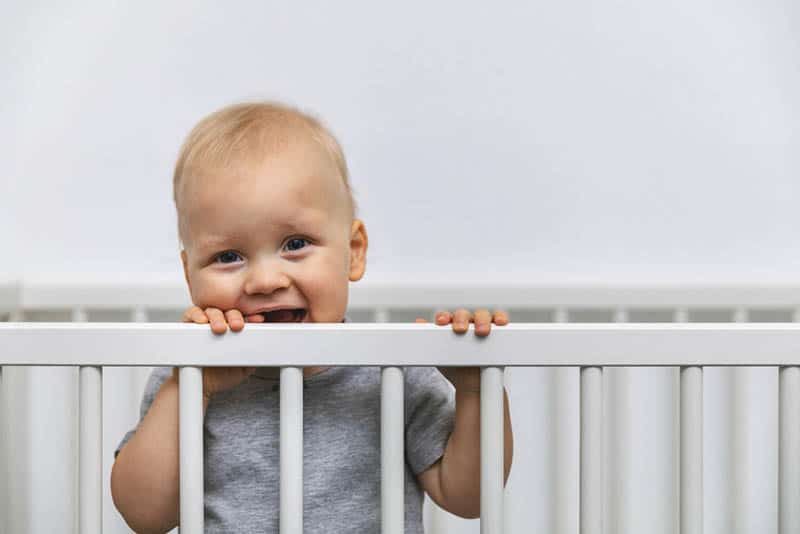
There are some things you have to pay special attention to when it comes to the crib rails as well.
Once again, your baby’s safety is the primary concern here and this is why you have to follow each one of these guidelines very carefully.
The first concern here is the width of the crib bars or slats.
The maximum space between the slats can’t be over 2 ⅜ inches or 6 cm.
This will prevent your child from pushing and trapping her head between the crib bars. Sadly, this could have a fatal outcome.
The same goes for cracked or missing crib rails – the space between them can be even more hazardous.
Also, the top of the crib rail must be at least 26 inches away from the top of the mattress.
3. Headboard and footboard
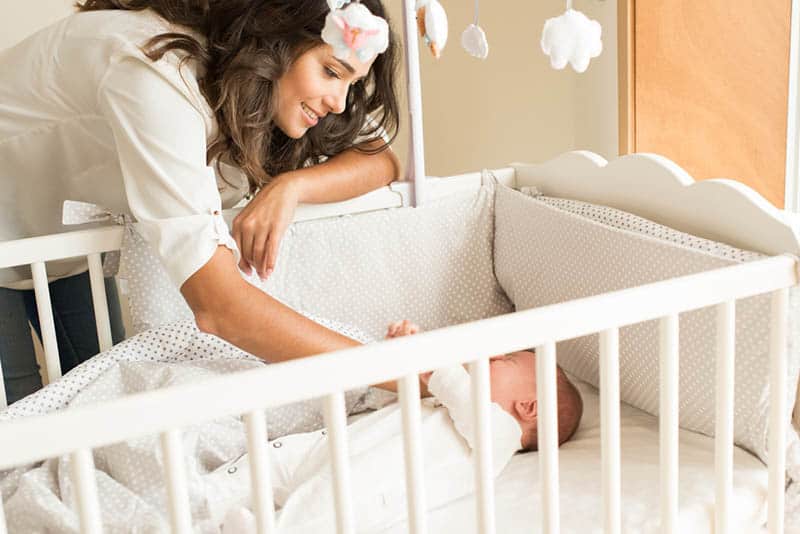
Even though different ornamental cut-outs can look cute on the headboard or footboard, they have no function at all.
Actually, they can only present a problem in the future, so avoid buying a crib decorated in this manner.
Your little one’s arms, legs, or head can easily get stuck in one of the holes, so why risk it?
4. Spare parts
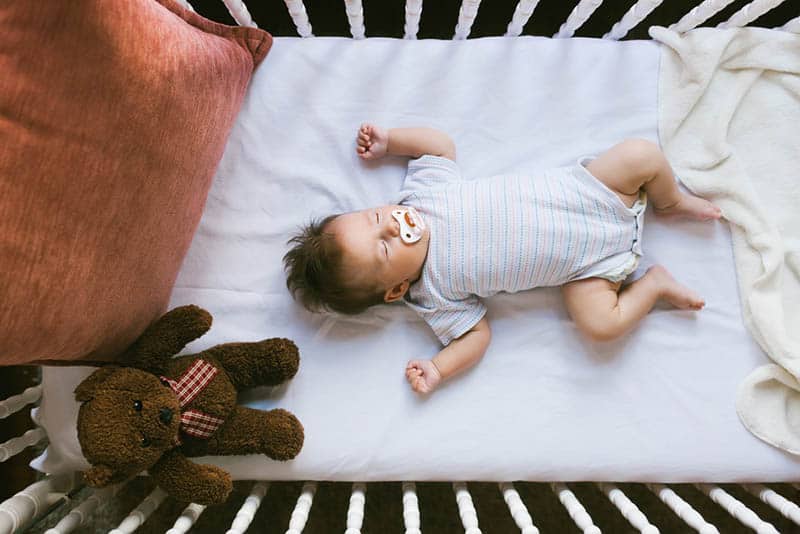
I know that you have a lot of expenses upon the arrival of your new baby but the last thing you should be saving money on is the crib’s spare parts.
If you have to change the original part, make sure to contact the manufacturer and always purchase the original one.
You might think that this is not necessary but trust me, it is.
Don’t forget that your baby is becoming more and more mobile with every new day.
Her movement in the crib can be the cause of the entire construction falling apart and consequently, seriously injuring herself.
This is especially important when you’re putting the product together for the very first time.
Every single working part has to be there and functioning perfectly.
5. Weekly inspection
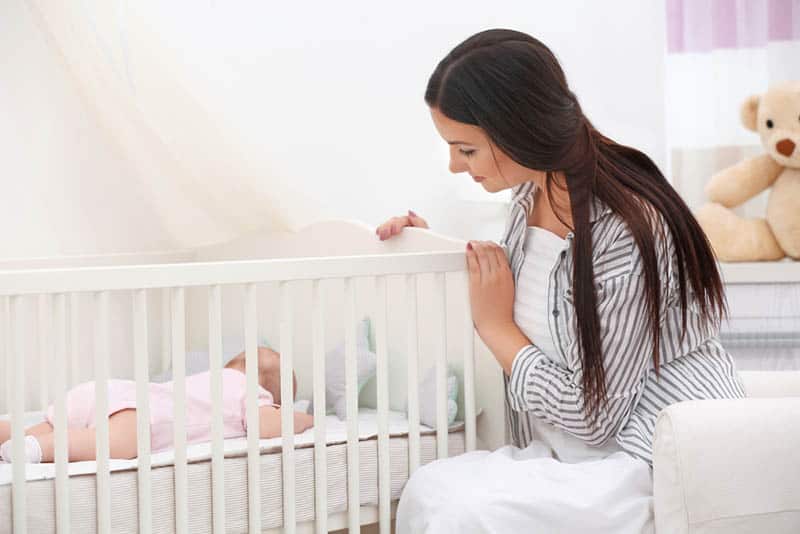
Finally, don’t forget about the weekly inspection of the crib.
Every seven days check the entire crib and make sure there aren’t any missing or broken parts or sharp edges, that all joints are firmly put together, and that the crib still complies with safety regulations.
To Wrap Up
Even though the question of when to lower crib is essential for your baby’s safety, that doesn’t mean that it should frighten you.
As long as you follow all the safety guidelines and precautions given by experts, you’re good to go and there is absolutely no reason to panic.
The different age estimations are not a rule: they only serve as a guideline.
That’s why it’s crucial for you to follow YOUR baby’s milestones before anything else.
At the end of the day, if you’re not sure about what to do, don’t hesitate to ask your pediatrician for advice – they’re the ones who’ll give you all the trustworthy health information.
Until next time mammas!
References:
• Shelov, S.P., Hannermann, R.E., Altmann, T.R. (2014) Caring for Your Baby and Young Child, 6th Ed: Birth to Age 5. Bantam.
Like this post? Please share or pin it for later. You can also stay in the loop and follow us on Facebook, Instagram or Pinterest.
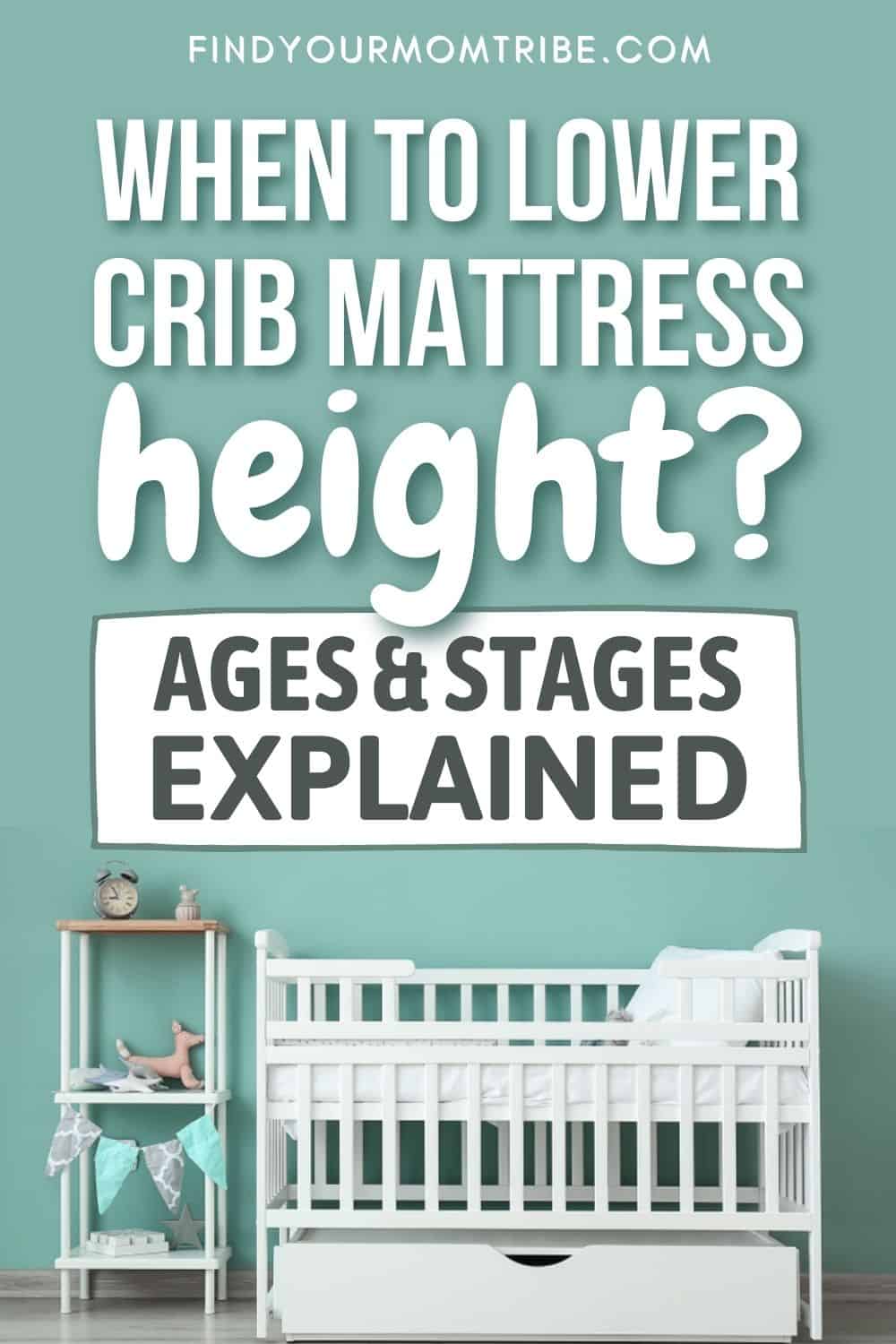
We love honesty! Find Your Mom Tribe is an Amazon Associate and we earn from qualifying purchases through affiliate links at no extra cost to you. Please see our full Amazon Affiliate disclosure for more information.

